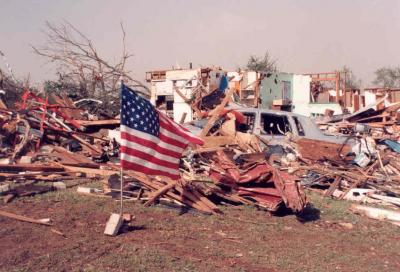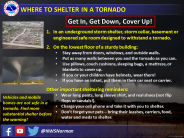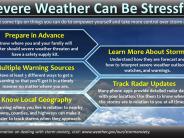Tornado Safety Guidelines
Your best defense against a tornado is to:
- Have a safety plan and practice it
- Pay attention to your local weather information, and
- Act quickly if a tornado threatens your area
Your chances of surviving even the strongest tornado are excellent if you follow these basic guidelines, even if no safe room or underground shelter is available.
BEFORE
- Develop a severe weather safety plan. Consider what actions you would take at home, work, school, or while commuting. Make sure you and your family understand where to go to stay safe in a tornado. Practice your plan. Do it now – don’t wait until storms are forecast!
- Your safety depends on you being aware of the latest severe weather outlooks, watches, and warnings. Have at least three different ways to get life-saving warnings. Different options include:
- NOAA weather radio
- National Weather Service website
- Local TV and Radio
- Weather apps for smartphones - no matter how many of these you have, they only count as one method
- Municipal or County sirens - but ONLY if you are outdoors; Sirens are not intended to be heard indoors!
- Know the difference between a watch and a warning:
- WATCH - Conditions are present for tornado development in or near the watch area. Tornadoes are possible. this is a good time to to review and discuss your emergency plans and check your supplies.
- WARNING - Take shelter immediately! A tornado has been sighted or indicated by radar. Warnings are typically for a much smaller area than watches.
WHEN STORMS THREATEN
- Stay calm, act quickly, and rely on your safety plan.
- The safest place to be in a tornado is an underground storm shelter, above ground safe room, or basement.
- If no underground shelter or safe room is available, go to the lowest level of a sturdy building or your home. Put as many walls between you and the outside direction of the storm as possible. Avoid windows, doors, and exterior walls. Closets and bathrooms are often good choices.
- Close all interior doors
- If possible, get under a sturdy table or desk. Cover up with thick items such as pillows or cushions to protect against flying debris. Put on a helmet if you have one
- If you are in a mobile home, in a vehicle, or outdoors, find a storm shelter or sturdy building quickly. Cars, trucks, and mobile homes offer little protection. You should NOT be in a mobile home or a vehicle during a tornado.
- If you will need to travel to get to a safe place, you need to plan to leave very early to avoid being caught in the weather or the traffic of other people trying to get to shelter.



